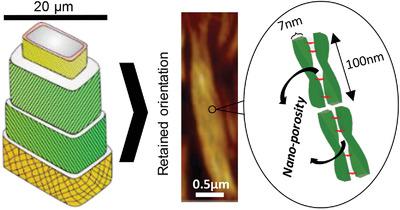当前位置:
X-MOL 学术
›
Macromol. Rapid Commun.
›
论文详情
Our official English website, www.x-mol.net, welcomes your
feedback! (Note: you will need to create a separate account there.)
Native Structure of the Plant Cell Wall Utilized for Top-Down Assembly of Aligned Cellulose Nanocrystals into Micrometer-Sized Nanoporous Particles.
Macromolecular Rapid Communications ( IF 4.2 ) Pub Date : 2020-07-01 , DOI: 10.1002/marc.202000201 Panagiotis Spiliopoulos 1 , Iina Solala 1 , Timo Pääkkönen 1 , Jani Seitsonen 2 , Bas van Bochove 3 , Jukka V Seppälä 3 , Eero Kontturi 1
Macromolecular Rapid Communications ( IF 4.2 ) Pub Date : 2020-07-01 , DOI: 10.1002/marc.202000201 Panagiotis Spiliopoulos 1 , Iina Solala 1 , Timo Pääkkönen 1 , Jani Seitsonen 2 , Bas van Bochove 3 , Jukka V Seppälä 3 , Eero Kontturi 1
Affiliation

|
Despite their sustainable appeal, biomass components are currently undervalued in nanotechnology because means to control the assembly of bio‐based nanoparticles are lagging behind the synthetic counterparts. Here, micrometer‐sized particles consisting of aligned cellulose nanocrystals (CNCs) are prepared by crosslinking cellulose in cotton linter fibers that are prehydrolyzed with gaseous HCl, resulting in chemical cleavage necessary for CNC formation but retaining the morphology of the native fibers. That way, the intrinsic alignment of cellulose microfibrils within the fiber cell wall can be retained and utilized for top‐down CNC alignment. Subsequent crosslinking with citric acid cements the alignment and preserves it, following the dispersion of CNCs trapped end‐to‐end, connected, and crosslinked within the colloidally stable micrometer‐sized particles. Furthermore, thermoporosimetry and cryogenic transmission electron microscopy (Cryo TEM) shows that the particles possess mainly nanoporous (<2 nm) character in water. The approach challenges the current paradigm of predominantly bottom‐up methods for nanoparticle assembly.
中文翻译:

植物细胞壁的天然结构,用于将自对准的纤维素纳米晶体自顶向下组装成微米级的纳米多孔颗粒。
尽管具有可持续发展的吸引力,但由于控制生物基纳米颗粒组装的方法落后于合成对等物,因此生物技术中的生物质组分目前仍被低估。在这里,由取向纤维素纳米晶体(CNC)组成的微米级颗粒是通过将棉短绒纤维中的纤维素交联而制备的,这些棉短绒纤维已被气态HCl预先水解,导致形成CNC所需的化学裂解,但保留了天然纤维的形态。这样,可以保留纤维素微纤维在纤维细胞壁内的固有排列,并用于自上而下的CNC排列。随后与柠檬酸的交联巩固了路线并保留了路线,随后分散了端对端,连接,并在胶体稳定的微米级颗粒内交联。此外,热孔隙率法和低温透射电子显微镜(Cryo TEM)表明,该颗粒在水中主要具有纳米孔(<2 nm)特征。该方法挑战了目前主要是自底向上的纳米颗粒组装方法的范式。
更新日期:2020-08-06
中文翻译:

植物细胞壁的天然结构,用于将自对准的纤维素纳米晶体自顶向下组装成微米级的纳米多孔颗粒。
尽管具有可持续发展的吸引力,但由于控制生物基纳米颗粒组装的方法落后于合成对等物,因此生物技术中的生物质组分目前仍被低估。在这里,由取向纤维素纳米晶体(CNC)组成的微米级颗粒是通过将棉短绒纤维中的纤维素交联而制备的,这些棉短绒纤维已被气态HCl预先水解,导致形成CNC所需的化学裂解,但保留了天然纤维的形态。这样,可以保留纤维素微纤维在纤维细胞壁内的固有排列,并用于自上而下的CNC排列。随后与柠檬酸的交联巩固了路线并保留了路线,随后分散了端对端,连接,并在胶体稳定的微米级颗粒内交联。此外,热孔隙率法和低温透射电子显微镜(Cryo TEM)表明,该颗粒在水中主要具有纳米孔(<2 nm)特征。该方法挑战了目前主要是自底向上的纳米颗粒组装方法的范式。











































 京公网安备 11010802027423号
京公网安备 11010802027423号